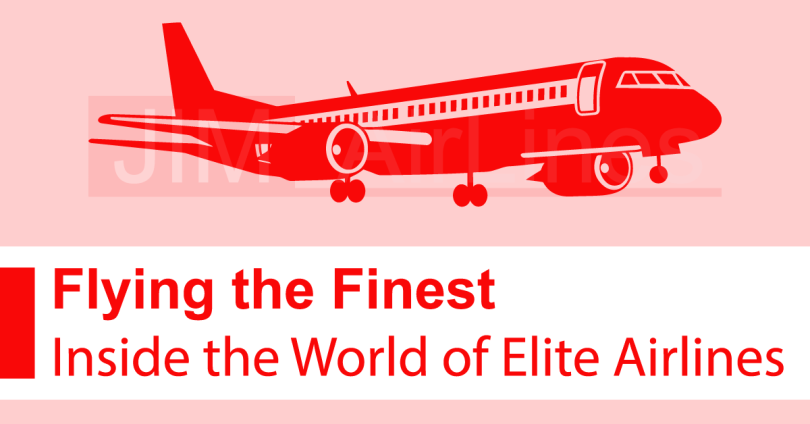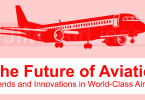Flying the world of elite airlines represents the epicenter of air travel, where luxury, service and innovation all come together to create an experience for passengers that’s second to none. From the moment a passenger books a ticket to the second they step off the aircraft, elite airlines strive to exceed expectations and transform ordinary travel into an extraordinary journey.
“Flying with the world’s best airline doesn’t depend on the destination. It’s about travel. where luxury convenience and service come together to redefine aviation. Every detail, from the seamless check-in process to the personalized in-flight experience, speaks to a standard of excellence that elevates the ordinary into the extraordinary.”
With this in-depth look, find out what makes them so different by exploring their history, characteristics, and special features that have kept them ahead in the competitive air travel market.
The Evolution of Elite Airlines
Early Days of Luxury Air Travel
During the early days, commercial aviation was only exclusive, expensive, and therefore luxury was automatic. Airlines like Pan Am and BOAC—now British Airways—were setting the example with spacious seating, fine dining, and a lot of tending. People dressed in their Sunday best to go flying, and the journey itself was an event just as glamorous as reaching the destination.
Modern Innovations
Fast-forward to the 21st century, and a whole new breed of premium airlines takes luxury to a whole new level. Rising to the occasion of global competition, airlines such as Emirates, Singapore Airlines, and Qatar Airways have redefined air travel with state-of-the-art aircraft and opulent cabin designs together with intuitive personalized service. Continuing to push the innovation boundaries, these leading airlines have invested billions in technologies that seek comfort, safety, and sustainability.
Defining Features of Elite Airlines
It is in the confluence of better attention to detail, leading-edge technology, and special commitment to service that truly makes the elites different. Here are the features that define their world-class status:
1. First-Class and Business-Class Suites
Premium cabin offerings are the hallmark of elite airlines. First-class suites often come with private spaces kitted out with fully flat beds, personal wardrobes, and even onboard showers in some. The Emirates first-class suite goes as far as to include a virtual window for seat positions without a real window and mood lighting to create a peaceful ambiance.
Business-class cabins used to be a step down; on many airlines, it now rivals first class. Qatar Airways’ Qsuite has passengers in their own pod with sliding doors, personalizable seating arrangements, and direct aisle access.
2. Impeccable In-Flight Service
Staff on elite airlines are trained to a level that brings a five-star-hotel type of service to the airplane, whether it be remembering passenger preferences or fulfilling every need on time to bring about an unforgettable and tailor-made experience.
3. Gourmet Dining
Food and beverage offerings on elite airlines are a high point of the experience: menus designed by well-known chefs, using local ingredients, paired with fine wines and signature cocktails. For example, Singapore Airlines works with an international culinary panel to create its inflight dining options; Etihad Airways offers an “onboard chef” service in first class.
4. Innovative In-Flight Entertainment
Top entertainment is offered on airlines by their great library of movies, TV programs, music, and games. Emirates ice system is always rated top with up to 5,000 channels. Some airlines go as far as offering live television and high-speed wi-fi connectivity so that passengers will always be able to keep in touch with what is happening around the world.
5. World-Class Lounges
The experience begins long before boarding with exclusive airport lounges that cater to premium passengers. These may have private sleeping pods, gourmet dining, spa facilities, and personalized concierge teams. Qatar Airways’ Al Mourjan Business Lounge in Doha and Turkish Airlines’ Istanbul Lounge form the very epitome of luxury on land.
6. Sustainability Initiatives
With the continuing trend toward sustainability, elite airlines have become the frontrunners in the effort to reduce their environmental footprint. In setting new paradigms for eco-conscious travel, they are adopting fuel-efficient aircraft like the Airbus A350 and Boeing 787, among other initiatives to reduce waste.
The Leaders in the Field
Some of the airliners are always rated among the best in the world for their never-ending effort to excel.
1. Emirates
Headquartered in Dubai, Emirates carries the connotation of sumptuousness. Its first-class suites, complete with sliding doors, minibars, and virtual windows, have redefined comfort. It’s also known for its ICE entertainment system and world-class lounges.
2. Singapore Airlines
Singapore Airlines is highly praised for its faultless service and innovative cabin design. It was the first to launch the Airbus A380 and introduced high-end suites with individual beds and chairs, setting a new benchmark in first-class travel.
3. Qatar Airways
Qatar Airways is well known for its Qsuite, providing unrivaled privacy and comfort in business class. This is further enhanced by the state-of-the-art lounges and smooth connections at its hub in Hamad International Airport in Doha.
4. Cathay Pacific
Hong Kong-based Cathay Pacific combines eastern hospitality with western efficiency. Its first class cabin allows for more spacious seating, fine dining, and exclusive access to The Pier and The Wing lounges in Hong Kong.
5. Etihad Airways
Abu Dhabi’s Etihad Airways takes luxury to new heights with its “Residence,” a three-room suite featuring a living room, bedroom, and private bathroom. The airline also provides a dedicated butler service for passengers in this class.
Read More Article’s
- A Complete Review: The Luxury of Flying with Singapore Airlines
- World Class Innovations – Future of Aviation
- 10 Reasons Why You Should Travel with World Class Airlines
- Flying High with ANA: Japan’s Best Airline Experience
- Emirates: The Sky’s Most Luxurious Service
The Business of Being Elite
The Role of Innovation
Innovation is always required in this competitive industry of aviation. Be it fuel-efficient aircraft or sophisticated booking systems, elite airlines invest heavily in technology that will further improve every facet of the passenger’s journey.
The Importance of Customer Loyalty
Frequent flyer programs provide a very important and critical function of retaining high-value customers. In this regard, programs such as Emirates Skywards and Singapore Airlines’ KrisFlyer members get special perks for loyalty in terms of upgrades, lounge access, and priority boarding.
Global Partnerships and Alliances
Elite airlines often cooperate through alliances like Oneworld, Star Alliance, and SkyTeam, offering passengers seamless travel across their affiliated carriers. Codeshare agreements further enhance connectivity, ensuring elite service extends to partner flights.
Challenges for Elite Airlines: The Future of Luxury Air Travel
Although elite airlines continue to raise the standards for the quality of luxury, exclusivity, and personalized services, a set of challenges do stand in the way for these carriers to maintain their elite position. These challenges are sniffing from various corners: economic factors, environmental sustainability, shifting customer expectations, and technological changes.
1. Increasing Operating Costs
Running an elite airline comes with significant operational costs, from maintaining a fleet of luxurious aircraft to employing highly trained staff and offering high-end services. The economic environment, particularly fluctuations in fuel prices, labor costs, and inflation, can put pressure on profitability. As global inflation rises and energy prices increase, elite carriers may struggle to keep their fares competitive while still offering top-tier service. The need to maintain profitability without sacrificing luxury is an ongoing balancing act.
2. Sustainability Pressures
As the world becomes more focused on sustainability, elite airlines face growing pressure to reduce their carbon footprints. The aviation industry is one of the largest contributors to global greenhouse gas emissions, and luxury airlines are no exception. Although a number of these luxury carriers are moving toward sustainable aviation fuels, investing in more fuel-efficient aircraft, and striving for carbon neutrality, the related technologies are very expensive. Furthermore, sluggish innovation in electric and hybrid aircraft manufacturing makes fully sustainable luxury air travel many years, if not decades, into the future.
3. Evolving Customer Expectations
Today’s high-net-worth travelers expect far more than just luxury; they demand seamless, bespoke experiences that take care of their every need. For elite airlines, this means continuous innovation in response to changing expectations for increasingly fast, efficient service. Customers want easy-to-use apps, real-time updates, and totally integrated digital experiences both on the ground and in the air. Furthermore, younger wealthy consumers are increasingly orienting their values toward sustainability and ethics, which may challenge elite airlines in product reinvention in an effort to be attractive to a newer generation of luxury consumers.
4. Competition from Private Aviation and Charter Services
Whereas elite airlines have been considered the gold standard for luxury travel, the offerings of private aviation and charter services have increased in popularity, offering a similarly exclusive experience with even greater flexibility. Luxury private jets offer ultimate privacy and can travel directly into smaller airports, economizing time, and provide a tailored service that may not always be emulated by elite airlines. The growing demand for private flights raises the challenge for elite airlines to demonstrate further differentiation and justify the premium price for commercial luxury flying.
5. Technological Challenges and Cybersecurity
While resourceful airlines are rapidly embedding advanced technologies, such as AI-driven personalization, biometric boarding, and in-flight connectivity, they are also making themselves more vulnerable to cybersecurity threats. The protection of sensitive passenger data, prevention of breaches, and safety of digital infrastructure are of utmost importance. Moreover, the smooth, seamless, and novelty technology of in-flight entertainment systems, Wi-Fi connectivity, and cabin customization require huge investment and continuous upgrading.
6. Economic Uncertainty and Global Events
Global events can include pandemics, geopolitical instability, or economic recessions, all of which have a significant effect on the luxury travel market. High-end travelers in the uncertain times of any event may delay or cancel trips, while government regulations regarding travel restrictions or stricter security measures may cause disruptions in flight schedules and dent demand for travel. Upscale airlines have to show versatility and adaptability by offering flexible booking policies that would ensure customer loyalty during such unpredictable times.
7. Talent Retention and Training
The quality of service aboard elite airlines reflects not only the skill but also the professionalism of their staff. Attracting and retaining top-tier talent, from flight attendants to concierge staff, can be challenging. Such staff must undergo extensive training to meet the lofty standards of elite service, but with the competitive nature of the luxury service industry, turnover can be a concern. The demand for excellent service means a high level of attention to detail and commitment from every employee, which can be a cause of burnout or fatigue.
There is no doubt that elite airlines will present an exciting future, but it’s clear that the industry has many challenges to go around as it innovates and continues to grow. This means that from navigating economic uncertainty and increased operational costs to concerns about sustainability and changing customer expectations, the most elite carriers must be agile and forward-looking to stay atop this platform in luxury travel. Rising to these challenges while continuing to provide unparalleled service and luxury will be the key to their continued success in a fast-changing world.
The Future of Elite Airlines: The future is bright for elite airlines — with a few exciting developments on the way.
- 1. Supersonic Flight Companies such as Boom Supersonic are developing aircraft that could cut travel times in half. Supersonic flights will likely first be adopted by elite airlines, with the service offered as a premium.
- 2. Space Tourism With companies like SpaceX and Blue Origin, a few elite airlines have been exploring partnership opportunities to offer suborbital flights as the greatest luxury experience.
- 3. Hyper-Personalization Advances in AI and data analytics will empower airlines to make every aspect of the passenger journey personalized, from meal preferences to entertainment, using individual profiles.
- 4. Fully Sustainable Flights Along with this, the call for sustainability will result in electric and hydrogen-powered aircraft, which will eventually make air travel clean and green.
Flying with a top airline is more than just transportation; it’s an experience that conveys luxury, innovation, and world-class service. From opulent first-class suites to personalized in-flight dining, these airlines redefine what it means to travel in style. With their continued innovation and adaptation to the dynamic nature of customer expectations, these elite airlines are going to be at the forefront of the industry, setting new standards for excellence in the skies. For those lucky enough to have flown with these airlines, the flight really is as memorable as the destination itself.







